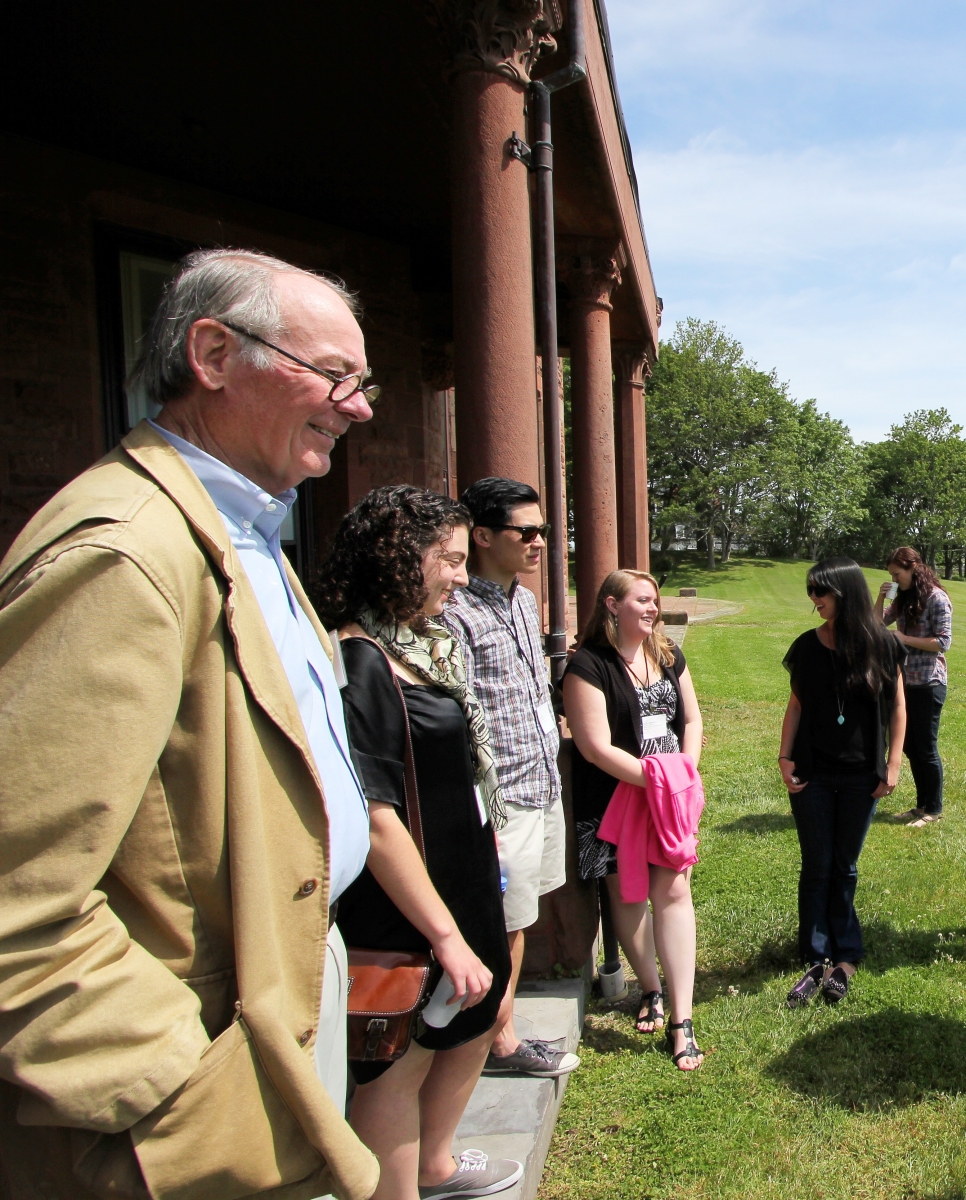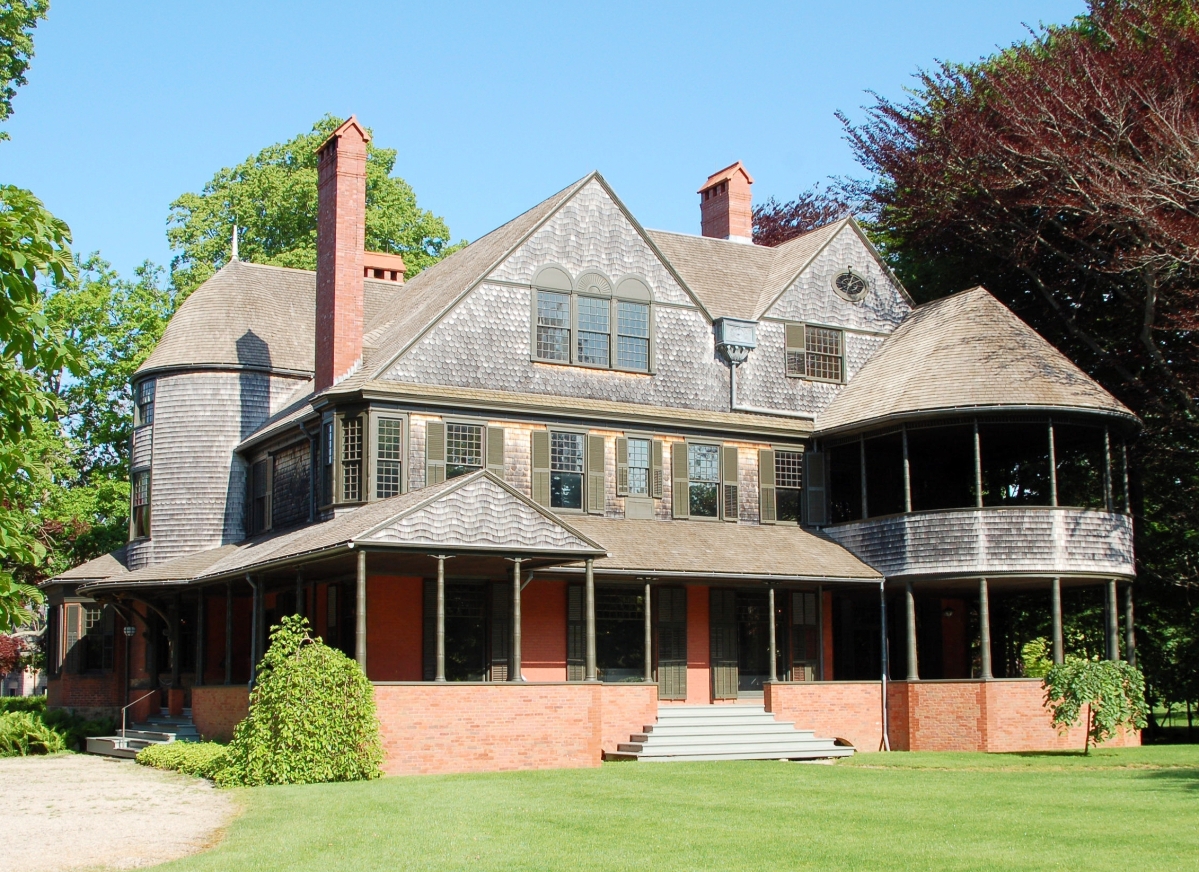
Architectural historian
Richard Guy Wilson, left, leads students on a tour of Vinland, Peabody and Stearns’ 1883 house for Catherine Lorillard Wolfe. He directs the Victorian Society in America’s annual summer school in Newport, R.I.
Richard Guy Wilson is one of America’s best-known experts on historic architecture. His many credits include a starring role in the A&E television series America’s Castles, which explored exceptional and eccentric haunts from Agecroft Hall in Virginia to the Winchester Mystery House in California. In the academic realm, Wilson – whose books include The Colonial Revival House, Edith Wharton at Home: Life at the Mount and Harbor Hill: Portrait of a House – has shaped a generation of scholars in his four-decade tenure at the University of Virginia, where he chairs the school’s distinguished program in architectural history. We spoke with Wilson about the Victorian Society in America’s annual summer school in Newport (June 2-11), which he has directed since 1979, and its companion programs in Chicago (June 15-20) and London (July 1-16).
What are you planning in Newport this year?
The purpose of the program is to look in depth at the architecture, related decorative arts and landscape design of the period. We let participants experience the well-known buildings such as the Breakers and Chateau Sur Mer, but also visit ones you may never see because they are private. We start with one of Newport’s few surviving Seventeenth Century buildings, the Wanton-Lyman-Hazard House. In the 1920s, architectural historian Norman Isham uncovered there what is the earliest American grain-painted wall. It dates to around 1690.
And field trips?
We travel to Pawtucket, R.I., to see the Slater Mill, the oldest surviving textile mill in the country, and the Modern Diner. It is one of two Sterling Steamliner diners still operating and dates to 1940. In Providence, we see the Fleur-de-lys Studios, built by the Art Workers Guild, one of the earliest Arts and Crafts groups in the United States, and the Providence Arcade, put up in 1828. We see the work of H.H. Richardson and others in North Easton, Mass. Unity Church has what are probably the finest windows by John LaFarge. On a trip to Fall River, Mass., we visit the Knapp House, designed by Ralph Adams Cram (1863-1942). It is probably the first Japanese Revival house in the United States and precedes the work the Greene brothers did in Pasadena, Calif., by a decade.
What about Chicago?
One of my first published books was on the Prairie School in Iowa and I’ve done a lot of work on the Arts and Crafts Movement, so design in the Midwest has always been an interest. I lecture in the Chicago summer school, based at the Art Institute, and help with the tours. The Art Institute has a tremendous collection, which we investigate. I like to take students to the old Marshall Field building, which has decoration by Tiffany and a small stained glass collection, then over to the old Chicago Public Library on Michigan Avenue. It features designs by Tiffany & Company and Louis Millet, who did a lot of work for Louis Sullivan. We go to Oak Park to see some things by Frank Lloyd Wright and will this year visit Crab Tree Farm, housing the Bryan collection.
Has curricula changed over the years?
It has evolved, yes. People today are more interested in who lived in the mansions year-round and how these places were maintained. There is a great deal of new research on decorative arts and landscape design, as well.
Are there alumni of all three programs?
A few people have somehow been able to do them all.
What advice do you have for Modernists on learning to love the Newport mansions?
You need to spend time with them. They are so complex. For me, one of the wonderful things about the summer programs is that I see something new each visit. And students always have fresh questions.
Have your own tastes changed?
Sure. I haven’t learned to hate anything, but there are more and more things one looks at. I’ve always been interested in Modern design. I grew up in Los Angeles in a house designed for my parents by Rudolph Schindler. My taste is very eclectic.
Favorite house, building or architect?
I admire many of them. In Newport alone, for instance, we see the tremendous evolution of Richard Morris Hunt’s work, starting with the 1864 Griswold House, now the Newport Art Museum.
Regarding current design trends, what dismays you? What pleases you?
Not much dismays me. The way we use houses has changed dramatically, which I fully understand and accept. I just hope we preserve the important features of these houses. As for new construction, there are presently some very good traditional or neo-traditional firms. Ferguson & Shamamian and Fairfax & Sammons, both with offices in New York City, come to mind.
Do you value the work you do for television?
Yes. It’s crucial that architectural historians and preservationists speak to the broader public. The built environment is important. It’s our legacy. We need to pay attention.
On what are you working now?
In advance of the University of Virginia’s bicentennial, I am writing a book on Monticello, to be published by Yale University Press in 2019. I’m also doing an exhibition here at UVA on Thomas Jefferson as an architect. His attention to detail was extraordinary. He was an architectural nut of the first order.
After 41 years, do you consider yourself a full-fledged Virginian?
One is all sorts of things. I spend my summers in Gilmanton, N.H. It’s a beautiful little place, with a small collection of Eighteenth and Nineteenth Century houses. My wife’s family started going there in the summer about a century ago. It’s where Grace Metalious wrote Peyton Place in the 1950s. Dr H.H. Holmes, the serial killer in The Devil in the White City, was born right up the street.
For more on the Victorian Society in America’s summer schools, visit www.vsasummerschools.org.
-Laura Beach





